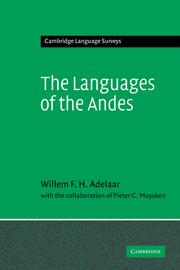Book contents
- Frontmatter
- Contents
- List of tables
- List of maps
- Preface
- Orthographic conventions
- List of abbreviations
- 1 Introduction
- 2 The Chibcha Sphere
- 3 The Inca Sphere
- 4 The languages of the eastern slopes
- 5 The Araucanian Sphere
- 6 The languages of Tierra del Fuego
- 7 The Spanish presence
- Appendix: Inventory of languages and language families of the Andean region
- References
- Author index
- Index of languages and ethnic groups
- Subject index
3 - The Inca Sphere
Published online by Cambridge University Press: 22 September 2009
- Frontmatter
- Contents
- List of tables
- List of maps
- Preface
- Orthographic conventions
- List of abbreviations
- 1 Introduction
- 2 The Chibcha Sphere
- 3 The Inca Sphere
- 4 The languages of the eastern slopes
- 5 The Araucanian Sphere
- 6 The languages of Tierra del Fuego
- 7 The Spanish presence
- Appendix: Inventory of languages and language families of the Andean region
- References
- Author index
- Index of languages and ethnic groups
- Subject index
Summary
The term ‘Inca Sphere’ is used to cover the area that falls within the limits of Tahuantinsuyo, ‘the Empire of the Four Quarters’, at the moment of its greatest extension under the Inca ruler Huayna Capac (c. 1520). It roughly coincides with the sphere of predominance of the Middle Andean civilisation before its destruction at the hands of Spanish conquerors in 1532–4. Speaking in modern terms, and from north to south, the Inca Sphere includes the Andean and Pacific regions of Ecuador, Peru, Bolivia, northern Chile and northern Argentina. (The languages of the Pacific region of northern Ecuador were discussed in chapter 2, whereas information on the Quechua variety spoken in Colombia is found in the present chapter.)
As we have indicated in the introductory chapter, the Middle Andean civilisation did not attain its greatest radiation until shortly before the European invasion. During the Middle Formative (800–400 BC) the predominance of Chavín de Huántar as a centre of cultural influence remained confined to portions of what is now central and northern Peru (Lumbreras 1974: 57–93). The period between 100 BC and AD 600 was marked by political disintegration, whereas the artistic production reached its highest peak in the history of the area with the development of the regional cultures of Paracas, Nazca and Mochica. After the decline of these local cultures, the influence of Pachacamac, situated just south of Lima at the mouth of the Lurín river, and Tiahuanaco on the Bolivian altiplano became strongly felt throughout the area.
- Type
- Chapter
- Information
- The Languages of the Andes , pp. 165 - 410Publisher: Cambridge University PressPrint publication year: 2004

